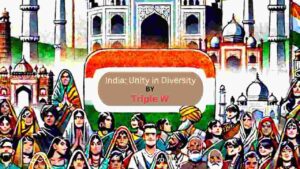
India: Unity in Diversity
India is a land of vibrant cultures, languages, and traditions, making it a living testament to the concept of “Unity in Diversity.” With over 1.3 billion people, India is home to multiple religions, ethnic groups, languages, and customs that coexist peacefully, creating a beautiful mosaic of diversity. Despite this vast multiplicity, there is an underlying sense of unity that binds the people of India together.
The Cultural Landscape of India
India’s diversity is most evident in its culture. The country has more than 2,000 distinct ethnic groups, and people speak over 1,600 languages. Each state in India has its own festivals, attire, food, and art forms. For example, while Diwali is celebrated with grandeur in the north, Pongal takes center stage in Tamil Nadu, and Onam is the major festival in Kerala. However, the spirit of celebration unites the entire nation, with people from different backgrounds coming together to partake in the festivities.
Religious Harmony
India is the birthplace of major world religions, including Hinduism, Buddhism, Jainism, and Sikhism, and is also home to followers of Islam, Christianity, Zoroastrianism, and Judaism. Despite the diverse religious practices, Indians have found ways to live in harmony. The constitutional values of secularism and equality provide a foundation for peaceful coexistence, and religious tolerance is ingrained in the Indian ethos.
Linguistic Diversity
The linguistic diversity of India is staggering, with 22 officially recognized languages in the Indian Constitution and numerous dialects spoken across the country. While Hindi and English serve as link languages in governance and communication, states have the freedom to promote their regional languages. Despite these linguistic differences, Indians have adapted to this multilingual environment with remarkable ease, and the love for one’s mother tongue has never clashed with national unity.
Social and Regional Diversity
The social fabric of India is characterized by caste, class, and regional identities. Different regions in India exhibit unique customs, architecture, and ways of life. For instance, Rajasthan is known for its desert culture, whereas Kerala is famous for its backwaters and greenery. Despite these regional and social distinctions, a sense of national pride unites Indians.
The Political System
India’s political system, based on federalism, ensures that each state can maintain its unique identity while being an integral part of the nation. The democratic framework allows for the expression of diverse opinions, making it a truly representative system. The unity of India lies in its acceptance of diversity at the grassroots level, where states and union territories retain their individuality but share a collective goal of national progress.
Conclusion
“Unity in Diversity” is not just a phrase but a living reality in India. Despite the vast differences in culture, language, and religion, Indians stand united with a common purpose and vision. The ability to embrace differences while maintaining harmony is what makes India unique and a symbol of true unity.
—
Disclaimer :
The information provided in this essay on “India: Unity in Diversity” is intended for educational and informational purposes only. While every effort has been made to ensure the accuracy of the content, the blog does not guarantee the completeness, reliability, or accuracy of the information. Readers are encouraged to verify facts and use this content as a reference guide. The blog ‘Triple W‘ holds no responsibility for any discrepancies or factual inaccuracies.